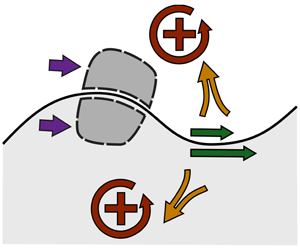Article contents
The generation and conservation of vorticity: deforming interfaces and boundaries in two-dimensional flows
Published online by Cambridge University Press: 10 March 2020
Abstract

This article presents a revised formulation of the generation and transport of vorticity at generalised fluid–fluid interfaces, substantially extending the work of Brøns et al. (J. Fluid Mech., vol. 758, 2014, pp. 63–93). Importantly, the formulation is effectively expressed in terms of the conservation of vorticity, and the latter is shown to hold for arbitrary deformation and normal motion of the interface; previously, vorticity conservation had only been demonstrated for stationary interfaces. The present formulation also affords a simple physical description of the generation of vorticity in incompressible, Newtonian flows: the only mechanism by which vorticity may be generated on an interface is the inviscid relative acceleration of fluid elements on each side of the interface, due to pressure gradients or body forces. Viscous forces act to transfer circulation between the vortex sheet representing the interface slip velocity, and the fluid interior, but do not create vorticity on the interface. Several representative example flows are considered and interpreted under the proposed framework, illustrating the generation, transport and, importantly, the conservation of vorticity within these flows.
JFM classification
- Type
- JFM Papers
- Information
- Copyright
- © The Author(s), 2020. Published by Cambridge University Press
References
Terrington et al. supplementary movie 1
Transient animation of the two-fluid Couette flow depicted in figure 8, with h1/h2 = 1, ν1/ν2 = 1, µ1/µ2 = 2 and U2 = 0.
Terrington et al. supplementary movie 2
Transient animation of the two-fluid Poiseuille flow depicted in figure 10, with h1/h2 = 1, ν1/ν2 = 4, and µ1/µ2 = 2.
Terrington et al. supplementary movie 3
Transient animation of the two-fluid Taylor-Couette flow depicted in figure 10, with rs/r2 = 2, r2/r1 = 3, ν1/ν2 = 1, and µ1/µ2 = 5.
Terrington et al. supplementary movie 4
Transient animation of the free-surface wave depicted in figure 14(a). The vertical scale is greatly exaggerated for clarity.
Terrington et al. supplementary movie 5
Transient animation of the viscous interface wave depicted in figure 14(b), with a density ratio ρ1/ρ2 = 2. The vertical scale is greatly exaggerated for clarity.
Terrington et al. supplementary movie 6
Transient animation of the interaction of a vortex pair with both a free-surface, and a viscous interface, as illustrated in figure 21. The froude number is Fr = 0.2 in both cases, while the density ratio across the viscous interface is ρ1/ρ2 = 100.
- 28
- Cited by


